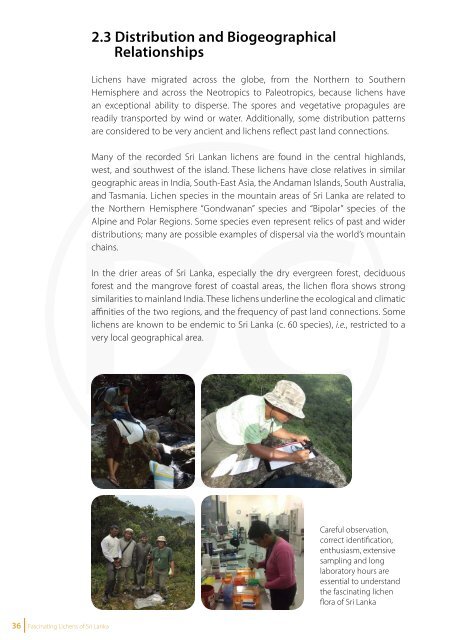Fascinating Lichens of Sri Lanka
Fascinating Lichens of Sri Lanka
Fascinating Lichens of Sri Lanka
- No tags were found...
You also want an ePaper? Increase the reach of your titles
YUMPU automatically turns print PDFs into web optimized ePapers that Google loves.
2.3 Distribution and Biogeographical<br />
Relationships<br />
<strong>Lichens</strong> have migrated across the globe, from the Northern to Southern<br />
Hemisphere and across the Neotropics to Paleotropics, because lichens have<br />
an exceptional ability to disperse. The spores and vegetative propagules are<br />
readily transported by wind or water. Additionally, some distribution patterns<br />
are considered to be very ancient and lichens reflect past land connections.<br />
Many <strong>of</strong> the recorded <strong>Sri</strong> <strong>Lanka</strong>n lichens are found in the central highlands,<br />
west, and southwest <strong>of</strong> the island. These lichens have close relatives in similar<br />
geographic areas in India, South-East Asia, the Andaman Islands, South Australia,<br />
and Tasmania. Lichen species in the mountain areas <strong>of</strong> <strong>Sri</strong> <strong>Lanka</strong> are related to<br />
the Northern Hemisphere “Gondwanan” species and “Bipolar” species <strong>of</strong> the<br />
Alpine and Polar Regions. Some species even represent relics <strong>of</strong> past and wider<br />
distributions; many are possible examples <strong>of</strong> dispersal via the world’s mountain<br />
chains.<br />
In the drier areas <strong>of</strong> <strong>Sri</strong> <strong>Lanka</strong>, especially the dry evergreen forest, deciduous<br />
forest and the mangrove forest <strong>of</strong> coastal areas, the lichen flora shows strong<br />
similarities to mainland India. These lichens underline the ecological and climatic<br />
affinities <strong>of</strong> the two regions, and the frequency <strong>of</strong> past land connections. Some<br />
lichens are known to be endemic to <strong>Sri</strong> <strong>Lanka</strong> (c. 60 species), i.e., restricted to a<br />
very local geographical area.<br />
A considerable amount <strong>of</strong> the lichen species <strong>of</strong> <strong>Sri</strong> <strong>Lanka</strong> are closely related to<br />
lichens <strong>of</strong> the Indo-Malaysian floristic region <strong>of</strong> the world, sharing many common<br />
families and genera. The close relationships between them are credited to their<br />
common origin in the ancient supercontinent <strong>of</strong> Gondwana.<br />
Many lichen species in <strong>Sri</strong> <strong>Lanka</strong> are cosmopolitan species.<br />
Cosmopolitan lichens are found in most vegetation types and habitats. They are<br />
most abundant around settled areas, on man-made substrates, and on exotic<br />
trees in plantations, parks and gardens. Disturbed, man-modified habitats<br />
are also lichen rich colonies and certain species are abundant in cardamom<br />
plantations in the Kalupahana-Knuckles mountain region. During the period <strong>of</strong><br />
British colonization, substantial areas <strong>of</strong> the central highlands were irrevocably<br />
altered by tea plantations, resulting in the local extinction <strong>of</strong> many lichen species.<br />
Nevertheless, some lichen species have managed to establish or survive in these<br />
areas, preserving an element <strong>of</strong> native vegetation in the altered environment<br />
and providing an important source <strong>of</strong> fascinating floristic diversity.<br />
3. Conserving and Studying<br />
<strong>Lichens</strong><br />
3.1 Conservation<br />
As a result <strong>of</strong> human activities, some lichens suffer adversely, like many other living<br />
things on this planet. Most lichens found in <strong>Sri</strong> <strong>Lanka</strong> are very tiny microlichens,<br />
hence it is not possible to immediately notice the loss <strong>of</strong> species or changes in<br />
distribution pattern. The loss <strong>of</strong> lichens mainly results from habitat destruction<br />
owing to atmospheric and aquatic degradation. <strong>Lichens</strong> quickly respond to air<br />
pollution and habitat changes. Their ecological roles and requirements are totally<br />
different from those <strong>of</strong> macro-organisms. Often without lichens, the survival <strong>of</strong><br />
macro-organisms is in danger as lichens are vital components <strong>of</strong> ecosystem<br />
function.<br />
Careful observation,<br />
correct identification,<br />
enthusiasm, extensive<br />
sampling and long<br />
laboratory hours are<br />
essential to understand<br />
the fascinating lichen<br />
flora <strong>of</strong> <strong>Sri</strong> <strong>Lanka</strong><br />
Both at species level and at a community level, much <strong>of</strong> the lichen flora is confined<br />
to montane, submontane, and rain forests in <strong>Sri</strong> <strong>Lanka</strong>. These vegetation types<br />
have the highest risk in the country. The utmost threat to <strong>Sri</strong> <strong>Lanka</strong>n lichens is via<br />
habitat destruction. When natural vegetation is replaced, be it agricultural land<br />
or plantation forest / monoculture plantations (e.g. Cardamom, tea), a substantial<br />
and irreplaceable segment <strong>of</strong> lichen diversity is inevitably lost.<br />
36 <strong>Fascinating</strong> <strong>Lichens</strong> <strong>of</strong> <strong>Sri</strong> <strong>Lanka</strong><br />
<strong>Fascinating</strong> <strong>Lichens</strong> <strong>of</strong> <strong>Sri</strong> <strong>Lanka</strong> 37
















